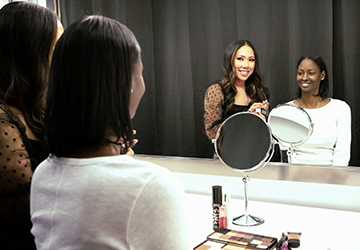4 Tips for Matching Your Foundation to Your Skin Tone
The best foundation is the secret to having a naturally healthy skin tone. However, picking the right makeup can be challenging due to the countless available choices.
The wrong choice can make you look in proportion and have a general appearance as if you have an awkward mix-match impression that hinders your glow.

In this blog post, we will share four critical pointers on how to nail the selection of your foundation. Consider these guidelines to get the best shade for yourself and look good.
Let's begin by learning how to find your ideal foundation shade!
Why Finding the Right Foundation is Crucial?
Ensuring that your shade blends well with the skin is essential when choosing the proper foundation. The positive results of the foundation are that it blends perfectly with skin tones, thus creating a smooth and appealing surface.
This way, if the client has skin issues, like discolouration, redness, or pimples, they will not be as noticeable when the proper foundation is applied. It gives the skin a non-blemish foundation layer that lets your skin glow naturally and aesthetically.
Furthermore, a great foundation will make you more comfortable with yourself as it helps you get the right colour. You will feel more confident about facing the world when you think your makeup is well-done and blends well with your natural looks.
The right base shade also complements other beauty products for your skin. It helps blend your blush, bronzer, and highlighter well to retain a natural look and finish.
4 Tips for Matching Your Foundation to Your Skin Tone
As we have seen, it is crucial to get the right match for our skin; here are four helpful steps to help you find the right shade for your complexion.
1. Identify Your Undertone
This is important when choosing a foundation because it's your skin's natural shade.
Cool undertones can be further classified as blue or pink, warm undertones can be classified as yellow or peach, and if you are still determining which category you belong to, you can be said to have neutral undertones.
One easy way to know this is by checking the colour of your veins on the inside of your wrist. You have cool undertones if your veins make you look blue or purple.
If you look green, then you are a warm undertone. If you find some of these characteristics, you have a neutral undertone.
Another method of fixing your undertone is to look at how you tan in the sun. If your skin complexion is inclined to reddening or blushing, you most likely have cool skin undertones.
If you can quickly, you have a warm undertone, meaning your skin colour leans toward the warm side of the spectrum.
2. Test Foundation in Natural Light
When swatching foundation, it is best to do so under daylight because artificial lighting can change the shade of your skin, creating a wrong perception of the fundamental foundation colour.
When matching to a foundation, apply a little colour on the side of your neck and mix it with your fingers. It is suitable for this as it is an area that gives you a picture of the overall skin tone.
Next, move outside or go to the window to assess the shade against the sunlight. They should blend with your skin to a point where people will not be able to notice that you have applied it or where the line between where your natural skin ends and the makeup begins cannot be seen.
3. Consider Seasonal Changes in Skin Tone
It is also important to note that the shade of our skin may differ according to the season, especially in winter; our skin may be slightly pale compared to the colours acquired in summer.
To ensure a perfect foundation match year-round, consider having two shades in your collection: A lighter one in the winter and a slightly darker one in the summer.
In intermediate seasons like spring and autumn, blending the two tones to create a more appropriate colour that complements the skin tone is possible.
4. Use Samples and Professional Help
If you are still looking for the right foundation shade, request swatches from the shops that sell beauty products. Most companies have compact packets or miniature foundation bottles that a shopper can carry home and compare the colours in varying surroundings.

Furthermore, consultations from a professional makeup artist or beauty consultant are perhaps as necessary as the other tips mentioned above. They are well-equipped to assess your skin tone and advise you on foundation shades.
Some cosmetic brands also offer foundation-matching services through online or physical stores. These tools select the skin tone and give individual advice about the preferable hue, so you don't have to guess.
Start Finding Your Perfect Foundation Match Today
So, if you want to find the perfect foundation match, follow these tips. You no longer should have to wait to have that perfect complexion and skin that accentuates your beauty.
Get started now and begin your journey to confidence with a solid foundation match. Other people, equally many, have already found their perfect tones and are reaping the advantages of smooth, flawless skin.
It would help if you learned how to immediately achieve the perfect look of a flawless foundation.
Frequently Asked Questions
Q. How do I determine my skin's undertone?
Ans To identify your undertone, check your veins: Blue/purple means excellent, green stands for warm, and if both colours are combined, it is considered in between. You can also notice how your skin behaves under the sun or which jewellery pieces make you look best.
Q. What should I do if my foundation looks different in various lighting?
Ans. Testing the foundation, especially when choosing a new one, is often recommended under artificial light to get an accurate picture of its appearance when applied. If it looks different under different lighting, apply it that way or wear the shade that looks better under the most frequently used lighting.
Q. Can I mix two foundation shades to get the perfect match?
Ans. Absolutely! Finding the right colour to blend with your skin tone is essential for foundation. If you are between two shades, you can mix the two.